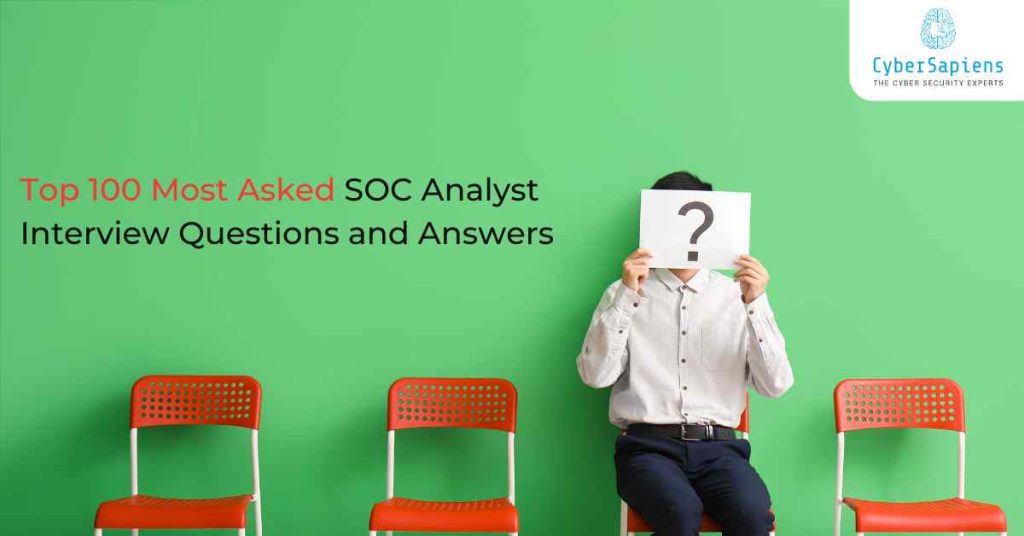As a Security Operations Center (SOC) analyst, you play a critical role in identifying, monitoring, and responding to cybersecurity threats. To land a job in this field, you need to be prepared to answer a range of questions that test your technical, analytical, and problem-solving skills. In this article, we’ll provide you with the top 100 most asked SOC analyst interview questions and answers, updated for 2024.
List of Top 100 Most Asked SOC Analyst Interview Questions and Answers | Updated 2024

Here is the list of “List of Top 100 Most Asked SOC Analyst Interview Questions and Answers“:
1. What is a Security Operations Center (SOC), and what is its primary function?
Ans: A Security Operations Center (SOC) is a centralized unit that monitors, detects, and responds to cybersecurity threats in real time. The primary function of a SOC is to identify, contain, and remediate security incidents to minimize the attack surface and prevent data breaches.
2. What is the difference between a SOC and a NOC (Network Operations Center)?
Ans: A SOC focuses on security threats and incident response, while a NOC focuses on network performance, uptime, and troubleshooting. While both centres monitor networks, the SOC’s primary concern is security, whereas the NOC’s primary concern is network availability and performance.
3. What are the key skills required for a SOC analyst?
Ans: Key skills required for a SOC analyst include:
- Strong understanding of cybersecurity principles and threat analysis
- Knowledge of security technologies such as firewalls, IDS/IPS, and SIEM systems
- Familiarity with incident response and crisis management
- Excellent analytical and problem-solving skills
- Strong communication and collaboration skills
- Ability to work under pressure and prioritize tasks effectively
4. What is threat intelligence, and how does it help in incident response?
Ans: Threat intelligence refers to the collection, analysis, and dissemination of information about potential or actual threats to an organization. Threat intelligence helps in incident response by providing context and insights about the tactics, techniques, and procedures (TTPs) used by attackers, enabling SOC analysts to respond more effectively and efficiently.
5. What is the Cyber Kill Chain, and how does it relate to incident response?
Ans: The Cyber Kill Chain is a model developed by Lockheed Martin that describes the stages of a cyber attack, from initial reconnaissance to exfiltration of data. The Cyber Kill Chain helps SOC analysts understand the attack lifecycle, enabling them to detect and respond to threats more effectively.
6. What is a SIEM system, and how does it help in threat detection?
Ans: A Security Information and Event Management (SIEM) system collects, monitors, and analyzes security-related data from various sources to provide real-time insights into security threats. SIEM systems help in threat detection by providing a centralized view of security events, enabling SOC analysts to identify and respond to threats more effectively.

7. What is incident response, and what are the key steps involved?
Ans: Incident response refers to the process of detecting, responding to, and containing security incidents. The key steps involved in incident response include:
- Identification and detection of the incident
- Initial response and containment
- Incident classification and prioritization
- Eradication and Recovery
- Post-incident activities and reporting
8. What is the NIST Cybersecurity Framework, and how does it relate to incident response?
Ans: The NIST Cybersecurity Framework is a set of guidelines and best practices for managing and reducing cybersecurity risks. The framework provides a structured approach to incident response, including identifying, protecting, detecting, responding, and recovering.
9. What is the difference between a vulnerability and an exploit?
Ans: A vulnerability is a weakness or flaw in a system, network, or application that can be exploited by an attacker. An exploit is the actual code or technique used to take advantage of a vulnerability.
10. What is a penetration test, and what is its purpose?
Ans: A penetration test is a simulated cyber attack against a computer system, network, or application to assess its security. The purpose of a penetration test is to identify vulnerabilities and weaknesses, enabling organizations to strengthen their defenses and prevent real-world attacks.
11. What is the role of a threat hunter in a SOC?
Ans: A threat hunter is a SOC analyst who proactively searches for threats that may have evaded traditional security controls. The role of a threat hunter is to identify and respond to unknown threats, using advanced techniques such as network traffic analysis and memory forensics.
12. What is the difference between a false positive and a false negative?
Ans: A false positive is a security alert that incorrectly identifies a legitimate event as malicious. A false negative is a security alert that fails to detect a real malicious event.
13. What is the importance of log analysis in incident response?
Ans: Log analysis is crucial in incident response as it provides valuable insights into security events, enabling SOC analysts to identify, contain, and remediate security incidents more effectively.
14. What is the role of a security information and event management (SIEM) system in log analysis?
Ans: An SIEM system collects, monitors, and analyzes security-related logs from various sources, providing real-time insights into security events.
15. What are the key benefits of using a SIEM system in a SOC?
Ans: Key benefits of using a SIEM system in a SOC include:
- Real-time threat detection and alerts
- Centralized log management and analysis
- Improved incident response and remediation
- Enhanced security visibility and situational awareness
- Compliance with regulatory requirements
16. What is the importance of threat intelligence in incident response?
Ans: Threat intelligence is crucial in incident response as it provides context and insights about the tactics, techniques, and procedures (TTPs) used by attackers, enabling SOC analysts to respond more effectively and efficiently.
17. What are some common types of cyber threats?
Ans: Common types of cyber threats include:
- Malware and ransomware
- Phishing and social engineering
- Advanced persistent threats (APTs)
- Distributed denial-of-service (DDoS) attacks
- Insider threats
- Cloud-based threats
18. What is the difference between a vulnerability scan and a penetration test?
Ans: A vulnerability scan is an automated process that identifies potential vulnerabilities in a system, network, or application. A penetration test is a simulated cyber attack that aims to exploit identified vulnerabilities to assess the overall security posture.
19. What is the importance of incident response planning?
Ans: Incident response planning is crucial as it enables organizations to respond quickly and effectively in the event of a security incident, minimizing the impact of the attack and reducing downtime.
20. What are some common incident response tools?
Ans: Common incident response tools include:
- SIEM systems
- Incident response platforms
- Threat intelligence tools
- Network traffic analysis tools
- Endpoint detection and response tools
21. What is the role of a SOC manager in incident response?
Ans: A SOC manager oversees the incident response process, ensuring that SOC analysts have the necessary resources and support to respond effectively to security incidents.
22. What is the importance of continuous monitoring in incident response?
Ans: Continuous monitoring is crucial in incident response as it enables SOC analysts to identify and respond to security threats in real-time, reducing the mean time to detect (MTTD) and mean time to respond (MTTR).
23. What is the difference between a security incident and a security breach?
Ans: A security incident is an event that may compromise the security of an organization’s assets. A security breach is a confirmed incident that has resulted in unauthorized access, use, disclosure, modification, or destruction of sensitive data.
24. What is the importance of communicating incident response to stakeholders?
Ans: Communicating incident response to stakeholders is crucial as it enables organizations to maintain transparency, build trust, and ensure compliance with regulatory requirements.
25. What are some common incident response metrics?
Ans: Common incident response metrics include:
- Mean time to detect (MTTD)
- Mean time to respond (MTTR)
- Mean time to resolve (MTTR)
- Incident response rate
- Security incident response efficiency
26. What is the role of automation in incident response?
Ans: Automation plays a crucial role in incident response by enabling SOC analysts to respond quickly and efficiently to security incidents, reducing the MTTD and MTTR.
27. What is the importance of continuous training and development in incident response?
Ans: Continuous training and development are essential in incident response as they enable SOC analysts to stay updated with the latest cybersecurity trends, technologies, and best practices.
28. What is the difference between a threat and a vulnerability?
Ans: A threat is a potential event that could compromise the security of an organization’s assets. A vulnerability is a weakness or flaw in a system, network, or application that can be exploited by an attacker.
29. What is the importance of threat modelling in incident response?
Ans: Threat modelling is crucial in incident response as it enables SOC analysts to identify potential threats and develop targeted countermeasures to mitigate them.
30. What is the role of artificial intelligence (AI) and machine learning (ML) in incident response?
Ans: AI and ML play a crucial role in incident response by enabling SOC analysts to analyze large datasets, identify patterns, and respond to security incidents more effectively.
31. What is the importance of collaboration and information sharing in incident response?
Ans: Collaboration and information sharing are crucial in incident response as they enable organizations to share threat intelligence, best practices, and knowledge to improve overall security posture.
32. What is the difference between a security incident and a disaster?
Ans: A security incident is an event that may compromise the security of an organization’s assets. A disaster is a catastrophic event that results in severe consequences, such as data loss, system downtime, or financial loss.
33. What is the importance of business continuity planning in incident response?
Ans: Business continuity planning is crucial in incident response as it enables organizations to minimize downtime and ensure business operations continue uninterrupted during a security incident.
34. What is the role of a chief information security officer (CISO) in incident response?
Ans: A CISO oversees the overall security posture of an organization, including incident response, ensuring that security strategies and practices align with business objectives.
35. What is the importance of compliance and regulatory requirements in incident response?
Ans: Compliance and regulatory requirements are crucial in incident response as they enable organizations to ensure compliance with laws, regulations, and industry standards, reducing the risk of fines and reputational damage.
36. What is the difference between a security operations centre (SOC) and a computer security incident response team (CSIRT)?
Ans: A SOC is a centralized unit that monitors, detects, and responds to cybersecurity threats in real-time. A CSIRT is a team that responds to and manages security incidents, often working closely with a SOC.
37. What is the importance of security awareness training in incident response?
Ans: Security awareness training is crucial in incident response as it enables employees to identify and report security threats, reducing the risk of insider threats and human error.
38. What is the role of an incident response team leader in incident response?
Ans: An incident response team leader oversees the incident response process, ensuring that team members have the necessary resources and support to respond effectively to security incidents.
39. What is the importance of continuous improvement in incident response?
Ans: Continuous improvement is crucial in incident response as it enables organizations to refine and optimize incident response processes, improving overall security posture and reducing the risk of future incidents.
40. What is the difference between a security orchestration, automation, and response (SOAR) solution and a security information and event management (SIEM) system?
Ans: A SOAR solution automates and orchestrates incident response processes, while a SIEM system collects, monitors, and analyzes security-related data.
41. What is the importance of threat hunting in incident response?
Ans: Threat hunting is crucial in incident response as it enables SOC analysts to proactively identify and respond to unknown threats, reducing the risk of advanced persistent threats (APTs) and zero-day attacks.
42. What is the role of a security architect in incident response?
Ans: A security architect designs and implements secure solutions, ensuring that security is integrated into the organization’s overall architecture and infrastructure.
43. What is the importance of security testing and validation in incident response?
Ans: Security testing and validation are crucial in incident response as they enable organizations to identify vulnerabilities and weaknesses, ensuring that security controls and countermeasures are effective.
44. What is the difference between a security incident response plan (SIRP) and a business continuity plan (BCP)?
Ans: A SIRP outlines the procedures for responding to security incidents, while a BCP outlines the procedures for ensuring business continuity during a disaster or crisis.
45. What is the importance of incident response metrics and key performance indicators (KPIs)?
Ans: Incident response metrics and KPIs are crucial as they enable organizations to measure and improve incident response efficiency, effectiveness, and overall security posture.
46. What is the role of a threat intelligence analyst in incident response?
Ans: A threat intelligence analyst collects, analyzes, and interprets threat data, providing insights and recommendations to improve incident response and overall security posture.
47. What is the importance of supply chain risk management in incident response?
Ans: Supply chain risk management is crucial in incident response, enabling organizations to identify and mitigate risks associated with third-party vendors and suppliers.
48. What is the difference between security and privacy incidents?
Ans: A security incident involves a breach of security controls, while a privacy incident involves a breach of personal data or sensitive information.
49. What is the importance of crisis management in incident response?
Ans: Crisis management is crucial in incident response as it enables organizations to respond effectively to high-severity incidents, minimizing reputational damage and ensuring business continuity.
50. What is the role of a communication specialist in incident response?
Ans: A communication specialist ensures that incident response communications are timely, accurate, and effective, maintaining transparency and trust with stakeholders.
51. What is the importance of employee involvement in incident response?
Ans: Employee involvement is crucial in incident response as it enables employees to identify and report security incidents, reducing the risk of insider threats and human error.
52. What is the difference between a security incident response team (SIRT) and a computer emergency response team (CERT)?
Ans: A SIRT is a team that responds to security incidents, while a CERT is a team that responds to emergencies and crises, often focusing on IT-related incidents.
53. What is the importance of stakeholder management in incident response?
Ans: Stakeholder management is crucial in incident response as it enables organizations to communicate effectively with stakeholders, including customers, employees, and partners.
54. What is the role of an incident response coordinator in incident response?
Ans: An incident response coordinator oversees the incident response process, ensuring that all stakeholders are informed and that incident response activities are coordinated effectively.
55. What is the importance of post-incident activities in incident response?
Ans: Post-incident activities, such as incident review and lessons learned, are crucial in incident response as they enable organizations to identify areas for improvement and optimize incident response processes.
56. What is the difference between a security incident response plan (SIRP) and a disaster recovery plan (DRP)?
Ans: A SIRP outlines the procedures for responding to security incidents, while a DRP outlines the procedures for recovering from a disaster or crisis.
57. What is the importance of training and exercises in incident response?
Ans: Training and exercises are crucial in incident response as they enable incident response teams to practice and refine their skills, ensuring effective response to security incidents.
58. What is the role of an incident response manager in incident response?
Ans: An incident response manager oversees the incident response process, ensuring that incident response activities are coordinated effectively and that incident response plans are implemented correctly.
59. What is the importance of supply chain incident response in incident response?
Ans: Supply chain incident response is crucial as it enables organizations to respond effectively to security incidents involving third-party vendors and suppliers.
60. What is the difference between security and service incidents?
Ans: A security incident involves a breach of security controls, while a service incident involves a disruption to normal service operations.
61. What is the importance of incident response policies in incident response?
Ans: Incident response policies are crucial as they provide guidelines and procedures for incident response, ensuring that incident response activities are consistent and effective.
62. What is the role of an incident response team member in incident response?
Ans: An incident response team member is responsible for responding to security incidents, following incident response procedures, and communicating with stakeholders.
63. What is the importance of incident response frameworks in incident response?
Ans: Incident response frameworks, such as NIST or ISO 27001, provide guidance and structure for incident response, ensuring that incident response activities are comprehensive and effective.
64. What is the difference between a security incident response plan (SIRP) and a business impact analysis (BIA)?
Ans: A SIRP outlines the procedures for responding to security incidents, while a BIA identifies the critical business processes and assets that require protection.
65. What is the importance of continuous monitoring in incident response?
Ans: Continuous monitoring is crucial in incident response as it enables organizations to detect and respond to security incidents in real-time, reducing the risk of advanced persistent threats (APTs) and zero-day attacks.
66. What is the role of an incident response team leader in incident response?
Ans: An incident response team leader oversees the incident response team, ensuring that incident response activities are coordinated effectively and that incident response plans are implemented correctly.
67. What is the importance of incident response metrics and KPIs in incident response?
Ans: Incident response metrics and KPIs are crucial in incident response as they enable organizations to measure and improve incident response efficiency, effectiveness, and overall security posture.
68. What is the difference between a security incident and a data breach?
Ans: A security incident involves a breach of security controls, while a data breach involves the unauthorized access, theft, or exposure of sensitive data.
69. What is the importance of incident response training for employees in incident response?
Ans: Incident response training for employees is crucial as it enables employees to identify and report security incidents, reducing the risk of insider threats and human error.
70. What is the role of an incident response communication plan in incident response?
Ans: An incident response communication plan outlines the procedures for communicating with stakeholders, including customers, employees, and partners, during a security incident.
71. What is the importance of incident response testing and exercises in incident response?
Ans: Incident response testing and exercises are crucial in incident response as they enable organizations to identify areas for improvement and refine incident response plans and procedures.
72. What is the difference between an incident response plan and a disaster recovery plan?
Ans: An incident response plan outlines the procedures for responding to security incidents, while a disaster recovery plan outlines the procedures for recovering from a disaster or crisis.
73. What is the role of an incident response coordinator in incident response?
Ans: An incident response coordinator oversees the incident response process, ensuring that all stakeholders are informed and that incident response activities are coordinated effectively.
74. What is the importance of incident response policies and procedures in incident response?
Ans: Incident response policies and procedures are crucial in incident response as they provide guidelines and procedures for incident response, ensuring that incident response activities are consistent and effective.
75. What is the role of an incident response team in incident response?
Ans: An incident response team is responsible for responding to security incidents, following incident response procedures, and communicating with stakeholders.
76. What is the importance of threat intelligence in incident response?
Ans: Threat intelligence is crucial in incident response as it enables organizations to identify and respond to emerging threats, improving incident response efficiency and effectiveness.
77. What is the difference between an incident response plan and a business continuity plan?
Ans: An incident response plan outlines the procedures for responding to security incidents, while a business continuity plan outlines the procedures for maintaining business operations during a crisis or disaster.
78. What is the role of an incident response manager in incident response?
Ans: An incident response manager oversees the incident response process, ensuring that incident response activities are coordinated effectively and that incident response plans are implemented correctly.
79. What is the importance of incident response reporting and analysis in incident response?
Ans: Incident response reporting and analysis are crucial in incident response as they enable organizations to identify areas for improvement and optimize incident response processes.
80. What is the difference between an incident response plan and a crisis management plan?
Ans: An incident response plan outlines the procedures for responding to security incidents, while a crisis management plan outlines the procedures for managing a crisis or emergency.
81. What is the role of an incident response team member in incident response?
Ans: An incident response team member is responsible for responding to security incidents, following incident response procedures, and communicating with stakeholders.
82. What is the importance of incident response planning in incident response?
Ans: Incident response planning is crucial in incident response as it enables organizations to prepare for and respond to security incidents, reducing the risk of reputational damage and financial loss.
83. What is the difference between a security incident response team (SIRT) and a computer security incident response team (CSIRT)?
Ans: A SIRT responds to security incidents that affect physical security, while a CSIRT responds to security incidents that affect computer systems and networks.
84. What is the role of an incident response coordinator in incident response?
Ans: An incident response coordinator oversees the incident response process, ensuring that all stakeholders are informed and that incident response activities are coordinated effectively.
85. What is the importance of incident response training for incident responders in incident response?
Ans: Incident response training for incident responders is crucial as it enables them to respond to security incidents effectively, improving incident response efficiency and effectiveness.
86. What is the difference between security and privacy incidents?
Ans: A security incident involves a breach of security controls, while a privacy incident involves the unauthorized collection, use, or disclosure of personal information.
87. What is the role of an incident response plan in incident response?
Ans: An incident response plan outlines the procedures for responding to security incidents, ensuring that incident response activities are consistent and effective.
88. What is the importance of incident response testing and exercises in incident response?
Ans: Incident response testing and exercises are crucial in incident response as they enable organizations to identify areas for improvement and refine incident response plans and procedures.
89. What is the difference between an incident response team and a crisis management team?
Ans: An incident response team responds to security incidents, while a crisis management team manages a crisis or emergency that affects the organization.
90. What is the role of an incident response manager in incident response?
Ans: An incident response manager oversees the incident response process, ensuring that incident response activities are coordinated effectively and that incident response plans are implemented correctly.
91. What is the importance of incident response communication in incident response?
Ans: Incident response communication is crucial in incident response as it enables organizations to communicate effectively with stakeholders, including customers, employees, and partners.
92. What is the difference between a security incident response plan and a disaster recovery plan?
Ans: A security incident response plan outlines the procedures for responding to security incidents, while a disaster recovery plan outlines the procedures for recovering from a disaster or crisis.
93. What is the role of an incident response team in incident response?
Ans: An incident response team is responsible for responding to security incidents, following incident response procedures, and communicating with stakeholders.
94. What is the importance of incident response metrics and KPIs in incident response?
Ans: Incident response metrics and KPIs are crucial in incident response as they enable organizations to measure and improve incident response efficiency, effectiveness, and overall security posture.
95. What is the difference between security and cyber incidents?
Ans: A security incident involves a breach of security controls, while a cyber incident involves a breach of cybersecurity controls.
96. What is the role of an incident response coordinator in incident response?
Ans: An incident response coordinator oversees the incident response process, ensuring that all stakeholders are informed and that incident response activities are coordinated effectively.
97. What is the importance of incident response planning in incident response?
Ans: Incident response planning is crucial in incident response as it enables organizations to prepare for and respond to security incidents, reducing the risk of reputational damage and financial loss.
98. What is the difference between a security incident response team (SIRT) and an incident response team (IRT)?
Ans: A SIRT responds to security incidents that affect physical security, while an IRT responds to security incidents that affect computer systems and networks.
99. What is the role of an incident response manager in incident response?
Ans: An incident response manager oversees the incident response process, ensuring that incident response activities are coordinated effectively and that incident response plans are implemented correctly.
100. What is the importance of incident response training for employees in incident response?
Ans: Incident response training for employees is crucial as it enables employees to identify and report security incidents, reducing the risk of insider threats and human error.
Why the above questions are useful?

Let’s see why the above questions are useful. The above questions are useful because they cover essential concepts, principles, and practices in incident response. Answering these questions demonstrates a thorough understanding of incident response and crisis management, which is critical for organizations to respond effectively to security incidents and crises.
1. Compliance
Some of the standards, including the PCI-DSS, HIPAA, and GDPR mandate the organizations to have an incident response plan and trained personnel to handle the security incidents.
2. Risk Management
Incident response is one of the elements of risk management that is crucial to any organization. It is for this reason that organizations need to be in a position of preparedness when it comes to security incidents since these can lead to damage to the organization’s reputation, monetary loss, and legal implications.
3. Security
Incident response is crucial for identifying, handling, and mitigating security incidents, including cyber threats, data breaches, and system failures.
4. Crisis Management
Crisis management is related to incident response as well. It has been seen that organizations need to be ready with their crisis management plans as a natural disaster, pandemic or any other eventuality can strike any time.
5. Business Continuity
Business continuity is important to any organization as it helps in the management of incidents that would otherwise occur and affect the normal running of the business.
Useful Resources:
Here are some useful resources related to Security Operation Center (SOC):
Conclusion
Therefore, anyone who is preparing for a Security Operation Center (SOC) interview must have a clear understanding of the following security concepts; security monitoring, incident response, threat analysis and security architecture.
It is crucial to know the following topics and solve sample questions; thus, you will be well-prepared for the job interviews. Ensure that you keep on learning new trends and technologies that are used in the SOC world to be successful.
FAQs: Top 100 Most Asked SOC Analyst Interview Questions and Answers
1. What mindset should I have before going to a SOC job?
Ans: Before going to a SOC job, you should have a growth mindset, be willing to learn, and be comfortable with ambiguity and uncertainty. You should also be able to work well under pressure and have strong problem-solving skills.
2. How can I stay motivated in a high-stress environment like a SOC?
Ans: To stay motivated in a high-stress environment like a SOC, set clear goals for yourself, celebrate your achievements, and take breaks to recharge. Practice self-care, prioritize your well-being, and seek support from colleagues and mentors.
3. How can I prepare myself for the 24/7 nature of a SOC?
Ans: To prepare yourself for the 24/7 nature of a SOC, develop a routine that includes regular exercise, healthy eating, and sleep habits. Learn to prioritize tasks, manage your time effectively, and take breaks to avoid burnout.












